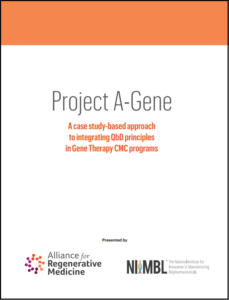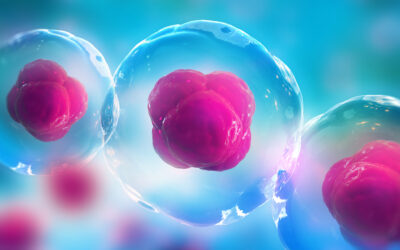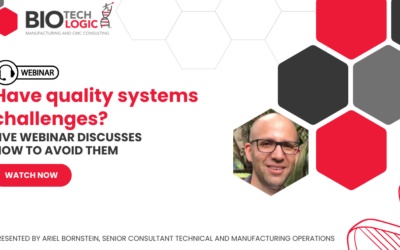
Cell and gene therapies have a potential, unlike anything we’ve ever seen before in medicine. With the power to deliver curative relief to patients suffering from debilitating conditions — many of which have no treatment options — the cell and gene therapy field is very much, to quote the Alliance for Regenerative Medicine’s annual report, “disrupting the status quo.”
There are currently close to 1,200 industry-sponsored trials ongoing, with about 12% of these in phase 3. But to get their therapies across the finish line and onto the market, developers must prove to the U.S. FDA that they have control over their processes and products.
This is accomplished by having a robust chemistry, manufacturing, and control (CMC) program.
Sufficient CMC information provided in a gene therapy IND will, according to the FDA, “assure product safety, identity, quality, purity and strength of the investigational product.”
But getting the CMC “right” is no small feat when it comes to cell and gene therapies. Despite significant advancements, there are still numerous technical challenges related to the manufacture of these advanced therapies. In addition, the regulatory path forward for gene therapies has been plagued by a lack of clarity. Even with new draft CMC guidance issued by the FDA in 2020, interpreting the regulator’s expectations remains an industry challenge.
Back in 2017, an audience of cell and gene therapy experts at the Alliance for Regenerative Medicine (AMR) CMC Summit were asked the question: “What is the biggest challenge to cell and gene CMC?
The audience agreed that many of the challenges in achieving streamlined, cost-effective manufacturing of cell and gene therapy products stemmed from a lack of standardized methodologies and training around CMC programs.
According to ARM, this scenario was familiar to those working in biologics, wherein both the monoclonal antibody and vaccine development sectors, “the whirl of energy around scientific discovery was stalled by the realities of manufacturing.” To help deal with industry growing pains, leading developers of monoclonal antibodies and vaccines embarked on projects that produced consolidated sets of recommendations for implementing Quality by Design (QbD). These projects, dubbed “A-Mab” and “A-Vax,” helped elevate best practices within their respective industries.
Borrowing from this model, the members of the Alliance for Regenerative Medicine decided to produce a similar document for use by the burgeoning cell and gene therapy sector. The result was Project A-Gene, a four-year effort addressing the challenges of manufacturing scale-up for cell and gene therapies.
Project A-Gene Goals
Project A-Gene was a collaborative effort that involved contributions from more than 50 industry experts from more than 20 leading therapeutics developers. In June 2021, the project results were shared in
a 225-page open-source document. Each chapter in the final document was meant to operate as an independent resource, united under a common narrative.
The primary purpose of the project was to:
- Establish best practices for process development in gene therapy
- Facilitate communication between teams
- Create a workforce development tool
- Educate regulators
Process Development Using QbD Principles
The past decade has significantly increased annual global clinical trials using AAV vector products. In gene therapy specifically, there are several advantages to using AAV vectors. Because of this, Project A-Gene presented a case study for a hypothetical AAV vector produced by a triple transfection process in a HEK 293 cell line, using QbD principles.
As gene therapy projects race towards late-stage development, it becomes increasingly important to establish and characterize a manufacturing process that can be scaled up to commercial-sized batches while continuing to yield a consistent, quality product. To accomplish this, experts in the field recommend using various systematic, risk-based approaches.
The Project A-Gene document discusses various aspects of QbD that are used to evaluate the process and mitigate risks. Risk-based approaches within the QbD process include:
- Critical quality attribute assessment
- Parameter risk assessment
- Process characterization
- Parameter criticality assessment
Given the case study model, Project A-Gene endeavored to establish a risk-based development approach that was fit for purpose to the AAV gene therapy modality. According to the Project A-Gene document, opportunities for a risk-based approach, specifically in the development of AAV products, include the following:
- Process characterization: risk assessments must be carried out to target the most critical parameters and limit the scope of experimentation
- Viral clearance: robust risk assessment must be carried out for non-helper virus processes
- Starting materials (e.g., plasmids, helper viruses, etc.): it is important to define a streamlined path to qualifying plasmid processes
Another way of ensuring that quality is built into the process is to mitigate risk by utilizing process analytical technology (PAT). Most of the techniques used in biologics may also be used in AAV-specific technologies, although some technologies are gene therapy-specific. For AAV, multiple PAT tools apply, but most techniques are still in the early stage.
Keeping Up with an Evolving Gene Therapy Field
Ultimately, the future of cost-effective gene therapies hinges on implementing common practices and the standardization of methods. Project A-Gene offers a snapshot of best practices in this rapidly evolving field.
BioTechLogic has had substantial success working with numerous gene therapy development teams to create CMC methodologies helping to advance therapeutics to market. We embrace Project A-Gene and other initiatives contributing to the challenging task of standardizing gene therapy development.
Gene therapy development can be daunting, so if BioTechLogic can help support your project, don’t hesitate to contact us.







